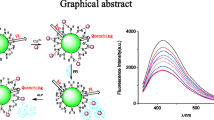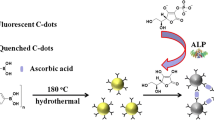Abstract
A method is described for the determination of the activity of alkaline phosphatase (ALP). It is based on the reversible modulation of the fluorescence of WS2 quantum dots (QDs). The fluorescence of the QDs is quenched by Cr(VI) but restored by free ascorbic acid (AA). The detection scheme relies on the fact that ALP hydrolyzes the substrate ascorbic acid 2-phosphate to produce AA, and that enzymatically generated AA can restore the fluorescence of the QDs. The signal (best measured at excitation/emission peak wavelengths of 365/440 nm) increases linearly in the 0.5 to 10 U·L−1 ALP activity range, with a detection limit of 0.2 U·L−1. The method was applied to the determination of ALP activity in human serum samples and demonstrated satisfactory results.

The fluorescence of chromate-loaded tungsten disulfide quantum dots (QDs) is quenched but restored after reaction with ascorbic acid that is formed by the catalytic action of alkaline phosphatase (ALP) on ascorbic acid 2-phosphate (AAP). The increase in fluorescence can be related to the activity of ALP.





Similar content being viewed by others
References
Kalantar-zadeh K, Ou J, Daeneke T, Strano M, Pumera M, Gras S (2015) Two-dimensional transition metal dichalcogenides in biosystems. Adv Funct Mater 25:5086–5099
Jariwala D, Sangwan V, Lauhon L, Marks T, Hersam M (2014) Emerging device applications for semiconducting two-dimensional transition metal dichalcogenides. ACS Nano 8:1102–1120
Huang X, Zeng Z, Zhang H (2013) Metal dichalcogenide nanosheets: preparation, properties and applications. Chem Soc Rev 42:1934–1946
Jiang H (2012) Electronic band structures of molybdenum and tungsten dichalcogenides by the GW approach. J Phys Chem C 116:7664–7671
Khataee A, Irani-nezhad M, Hassanzadeh J (2018) Improved peroxidase mimetic activity of a mixture of WS2 nanosheets and silver nanoclusters for chemiluminescent quantification of H2O2 and glucose. Microchim Acta 185:190
Hao L, Gu H, Duan N, Wu S, Ma X, Xia Y, Tao Z, Wang Z (2017) An enhanced chemiluminescence resonance energy transfer aptasensor based on rolling circle amplification and WS2 nanosheet for Staphylococcus aureus detection. Anal Chim Acta 959:83–90
Shorie M, Kumar V, Kaur H, Singh K, Tomer V, Sabherwal P (2018) Plasmonic DNA hotspots made from tungsten disulfide nanosheets and gold nanoparticles for ultrasensitive aptamer-based SERS detection of myoglobin. Microchim Acta 185:158
Zhang X, Lai Z, Liu Z, Tan C, Huang Y, Li B, Zhao M, Xie L, Huang W, Zhang H (2015) A facile and universal top-down method for preparation of monodisperse transition-metal dichalcogenide nanodots. Angew Chem Int Ed 54:5425–5428
Lin L, Xu Y, Zhang S, Ross I, Ong A, Allwood D (2013) Fabrication of luminescent monolayered tungsten dichalcogenides quantum dots with giant spin-valley coupling. ACS Nano 7:8214–8223
Song X, Zhang Z, You J, Liu D, Li H, Cao G, Xiao M, Guo G (2015) Temperature dependence of coulomb oscillations in a few-layer two-dimensional WS2 quantum dot. Sci Rep 5:16113
Long H, Tao L, Chiu C, Tang C, Fung K, Chai Y, Tsang Y (2016) The WS2 quantum dot: preparation, characterization and its optical limiting effect in polymethylmethacrylate. Nanotechnology 27:414005
Valappil M, Anil A, Shaijumon M, Pillai V, Alwarappan S (2017) A single-step electrochemical synthesis of luminescent WS2 quantum dots. Chem Eur J 23:9144–9148
Kim M, Jeon S, Kang T, Ju J, Yim D, Kim H, Park J, Kim J (2017) 2H-WS2 quantum dots produced by modulating the dimension and phase of 1T-nanosheets for antibody-free optical sensing of neurotransmitters. ACS Appl Mater Interfaces 9:12316–12323
Guo X, Wang Y, Wu F, Ni Y, Kokot S (2015) The use of tungsten disulfide dots as highly selective, fluorescent probes for analysis of nitrofurazone. Talanta 144:1036–1043
Yan Y, Zhang C, Gu W, Ding C, Li X, Xian Y (2016) Facile synthesis of water-soluble WS2 quantum dots for turn-on fluorescent measurement of lipoic acid. J Phys Chem C 120:12170–12177
Bai X, Wang J, Mu X, Yang J, Liu H, Xu F, Jing Y, Liu L, Xue X, Dai H, Liu Q, Sun Y, Liu C, Zhang X (2017) Ultrasmall WS2 quantum dots with visible fluorescence for protection of cells and animal models from radiation-induced damages. ACS Biomater Sci Eng 3:460–470
Yong Y, Cheng X, Bao T, Zu M, Yan L, Yin W, Ge C, Wang D, Gu Z, Zhao Y (2015) Tungsten sulfide quantum dots as multifunctional nanotheranostics for in vivo dual-modal image-guided photothermal/radiotherapy synergistic therapy. ACS Nano 9:12451–12463
Xu S, Li D, Wu P (2015) One-pot, facile, and versatile synthesis of monolayer MoS2 /WS2 quantum dots as bioimaging probes and efficient electrocatalysts for hydrogen evolution reaction. Adv Funct Mater 25:1127–1136
Yao J, Yang M, Duan Y (2014) Chemistry, biology, and medicine of fluorescent nanomaterials and related systems: new insights into biosensing, bioimaging, genomics, diagnostics, and therapy. Chem Rev 114:6130–6178
Fernandez N, Kidney B (2007) Alkaline phosphatase: beyond the liver. Vet Clin Pathol 36:223–233
Li P, Hong Y, Feng H, Li S (2017) An efficient “off–on” carbon nanoparticle-based fluorescent sensor for recognition of chromium(VI) and ascorbic acid based on the inner filter effect. J Mater Chem B 5:2979–2988
Gong X, Liu Y, Yang Z, Shuang S, Zhang Z, Dong C (2017) An “on-off-on” fluorescent nanoprobe for recognition of chromium(VI) and ascorbic acid based on phosphorus/nitrogen dual doped carbon quantum dot. Anal Chim Acta 968:85–96
Rong M, Lin L, Song X, Wang Y, Zhong Y, Yan J, Feng Y, Zeng X, Chen X (2015) Fluorescence sensing of chromium(VI) and ascorbic acid using graphitic carbon nitride nanosheets as a fluorescent “switch”. Biosens Bioelectron 68:210–217
Huang S, Qiu H, Zhu F, Lu S, Xiao Q (2015) Graphene quantum dots as on-off-on fluorescent probes for chromium(VI) and ascorbic acid. Microchim Acta 182:1723–1731
Zheng M, Xie Z, Qu D, Li D, Du P, Jing X, Sun Z (2013) On−off−on fluorescent carbon dot nanosensor for recognition of chromium(VI) and ascorbic acid based on the inner filter effect. ACS Appl Mater Interfaces 5:13242–13247
Huang H, Wang B, Chen M, Liu M, Leng Y, Liu X, Li Y, Liu Z (2016) Fluorescence turn-on sensing of ascorbic acid and alkaline phosphatase activity based on graphene quantum dots. Sens Actuators B Chem 235:356–361
Halawa M, Gao W, Saqib M, Kitte S, Wu F, Xu G (2017) Sensitive detection of alkaline phosphatase by switching on gold nanoclusters fluorescence quenched by pyridoxal phosphate. Biosens Bioelectron 95:8–14
Xue Q, Cao X, Zhang C, Xian Y (2018) Polydopamine nanodots are viable probes for fluorometric determination of the activity of alkaline phosphatase via the in situ regulation of a redox reaction triggered by the enzyme. Microchim Acta 185:231
Mao M, Tian T, He Y, Ge Y, Zhou J, Song W (2018) Inner filter effect based fluorometric determination of the activity of alkaline phosphatase by using carbon dots codoped with boron and nitrogen. Microchim Acta 185:17
Wang H, Li Y, Chen Y, Zhang Z, Gan T, Liu Y (2018) Determination of the activity of alkaline phosphatase by using nanoclusters composed of flower-like cobalt oxyhydroxide and copper nanoclusters as fluorescent probes. Microchim Acta 185:102
He Y, Jiao B (2017) Determination of the activity of alkaline phosphatase based on the use of ssDNA-templated fluorescent silver nanoclusters and on enzyme-triggered silver reduction. Microchim Acta 184:4167–4173
Acknowledgements
This work was supported by the National Natural Science Foundation of China (NSFC, 21605012 and 21674066), Ministry of Education of Liaoning Province (No. L2016022), and the Program for Top-Notch Young Innovative Talents of Chongqing Normal University (No. 02030307-00043).
Author information
Authors and Affiliations
Corresponding author
Ethics declarations
The author(s) declare that they have no competing interests.
Electronic supplementary material
ESM 1
(DOCX 2043 kb)
Rights and permissions
About this article
Cite this article
Hu, L., Zhang, Q., Gan, X. et al. Fluorometric turn-on determination of the activity of alkaline phosphatase by using WS2 quantum dots and enzymatic cleavage of ascorbic acid 2-phosphate. Microchim Acta 185, 390 (2018). https://doi.org/10.1007/s00604-018-2929-9
Received:
Accepted:
Published:
DOI: https://doi.org/10.1007/s00604-018-2929-9




